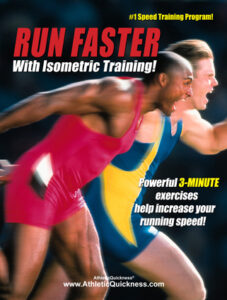Why Most ‘Speed’ Training Programs Don’t Deliver As Advertised …..
I’m always intrigued when I see or read about some new way to train your muscles specifically for speed. Very recently, I was watching television, and the people were demonstrating how they would train their muscles to get faster.
The exercises they were showing consisted of the following:
1) One exercise consisted of a large resistance band. The band was fixed to something on the wall and the person (facing the wall as well) was pulling the bands with both hands back towards them (similar to a rowing motion on a weight machine), over and over again, as fast as possible.
Not a bad idea. It’s a very functional exercise that will help develop strength in you erector spinae muscles of the lumbar spine, along with extensors of the arm such as your lats, posterior deltoids and teres minor muscles.
2) Another exercise consisted of a person who had a very large resistance band tied around his waist and another person was holding on to the other end about ten feet behind him. The person in front then started to run and the person behind him holding the band was following too, except they were trying to run at a slower pace, thus producing tension in the band to make it harder for the first person to run.
Again, not a bad idea. For the most part, its safe and there should be a low risk of injury. Exercises like these help train your quadriceps, hip extensors, and calf muscles.
3) Another of their speed training exercises consisted of what appeared to be markings (made of either tape or paint) on the floor in the shape of squares. The person then began to randomly jump with both feet in and out of these squares, with the coach/trainer, encouraging the athlete to go “faster and faster”.
A very nice exercise for helping increase your coordination. Also a good exercise for improving balance as well as strengthening your ankles in all planes of motion.
4) And finally, the last exercise they showed was an athlete holding on to two small dumbbells weighing about twenty pounds each. They were performing biceps curls and again, the coach/trainer was encouraging the athlete to do them faster and faster.
[sc name=”2-stepoptin-blue”]
More of a finishing type of exercise where you are trying to get the last extra burn in the biceps and perhaps brachialradialis muscles before moving on to a different body part.
At first I thought this was a program teaching people just a few more ways to train their muscles to get stronger; something different you could do to break up your normal workout.
When I heard the host of the show state that these exercises were a breakthrough in speed training, I was totally shocked.
With all due respect for these well-meaning individuals, there is no way any of these exercises will make you faster any more than what a lot of people would normally be doing when they go to the gym in the first place. To call these exercises a breakthrough in speed training is a bit of a stretch.
Here’s why:
First of all, when training with resistance bands, you should be aware that when you start an exercise, you are typically at your weakest. This is because your joints are typically fully extended where you cannot get much leverage and there is no momentum from the exercise that you can initially take advantage of such as is common with body weight exercises.
Combine this with the resistance band having not yet been stretched to a point where its resistance has any impact on the exercise, and you can see where the beginning of any exercise using an un-stretched band will have little or no effect on your conditioning.
This is the case for the first exercise mentioned above during the rowing motion. The only real effect of this type of training is in the latter part of the exercise. Due to the change in resistance that bands provide when being stretched, performing repetitions with them is not the best way to utilize them from a strength and/or speed perspective. Knowing how to maximize the benefits of an elastic resistance band is critical to developing fast muscle contractions, and doing repetitions is not most effective.
The second exercise mentioned above is also a good exercise, and one that is popular, since it is likely to train certain muscle groups involved in the running motion.
Where this exercise is likely to disappoint you, as it relates to helping you increase your running speed, is that, first, the muscles trained during this exercise only affect about half of the muscles needed for sprinting faster.
How can this be? Well, if you look at the muscles that are undergoing resistance for this type of an exercise, you will notice that it involves your 1) hip extensors, 2) knee extensors, and 3) ankle plantarflexors. Your hip flexors and knee flexors do not undergo ANY additional resistance with this exercise.
So what’s wrong with that?
Well, nothing, if all you want to train is these muscle groups. However, as we have pointed out numerous times on this website, your hip flexors play a huge role in sprinting but don’t receive any attention during these exercises and are also likely not to receive any attention in the gym either.
Your hip flexors determine how fast you can get your trailing leg out in front of you and back into position on the ground and also helps establish the length of your stride. These factors pay a huge role in how fast you will run.
There are 7 muscles that make up your hip flexors that more often than not go untrained every single day. This leaves a huge deficit (almost 40%!) in your training.
The 2nd problem here is that when you think you are trying something new and different with exercises such as these, it isn’t that much different than what you might already be doing in the gym on the squat rack or leg extension machine.
This is why you may not see any gains in speed with this exercise since you may have already peaked these muscles’ strength by doing other exercises. And as far as this exercise is concerned, the same applies when you run down the track with a parachute or weight sled.
Basically, this is a strength and endurance exercise, not a speed development exercise.
The third exercise involved an agility technique of jumping-in and out of painted squares on the floor. Great agility and coordination exercise.
This exercise will help you with your coordination along with helping to strengthen your ankle joints. Strong ankle joints is a huge benefit to any athlete, since it is one of the easier joints to injure due to the amount of weight and varying angles of stress placed on it.
As far as a being part of a breakthrough speed training technique that the show advertised, I really didn’t see much improvement beyond greater speed due to agility and coordination of muscle activity.
[sc name=”2step-optin”]
The last exercise involved performing biceps repetitions with 20 lb. dumbbells over and over again to exhaustion. This is what a lot of people like to do with a lot of different types of exercises and call them speed training routines.
I’ll go along with that to a point, however here is where you might run in to trouble with this type of training; fast twitch muscle fibers, which the biceps is loaded with, along with the long muscles in the legs, tend to fatigue very quickly.
The challenge with doing this type of training (fast repetitive weight lifting) to a point of immediate exhaustion and then beyond is that physiologically you start to develop slow twitch muscle traits within the fast twitch muscle. This can be detrimental to your speed gains.
But as far as being a breakthrough in speed training, there isn’t that much different here than what has been typically done to the biceps for years.
So what is a breakthrough speed training strategy
that delivers breakthrough result?
Learning how to take advantage of the elastic properties of the resistance band and using it to force an immediate over-stimulation of the muscle will target your fast twitch muscle fibers in very different ways than conventional exercises.
This results in quicker and more powerful muscle contractions without adding any significant body weight that might be counterproductive to your athletic speed.
We are fully aware that a complete training program requires a variety of drills and workouts, including strength training, coordination, and skill development, as well as isometrics with the resistance band for fast and powerful muscle contraction speed.
It doesn’t need to be complicated – Just don’t confuse the various purposes of these types of training.
Athletes sometimes think they are training for speed when their muscles are actually training for strength, and that is why they are often disappointed with their speed gains.
More about the resistance band and speed development.
[sc name=”mma testimonial banner – green”]
[sc name=”Order Here Button-01″]
Always glad to help.
Dr. Larry Van Such






